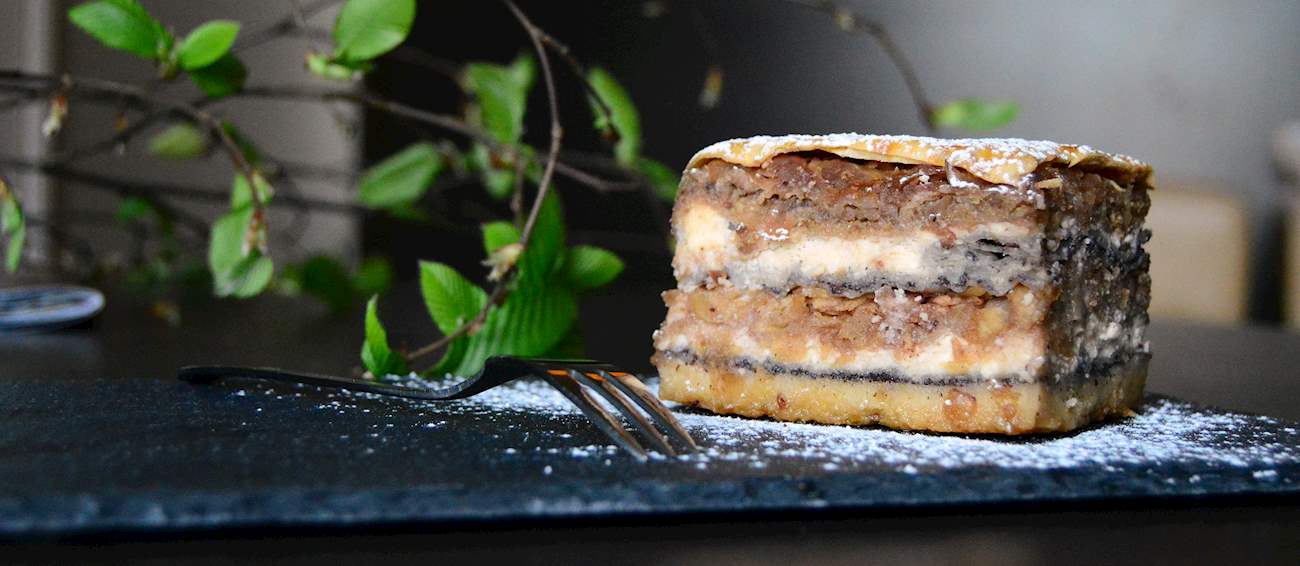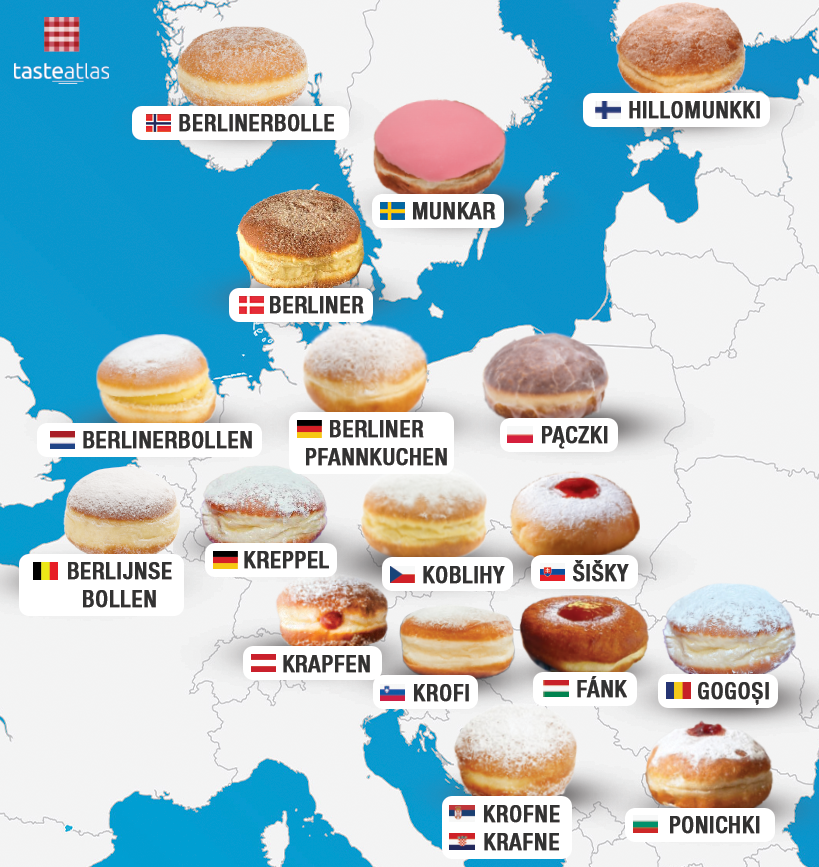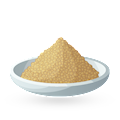TABLE OF CONTENTS
Best Slovenian Foods
Krapfen was probably the first European-style doughnut to appear, followed by similar varieties in other countries. These pastries are traditionally prepared with leavened dough that is deep-fried until golden and crispy on the outside, while they remain soft, light, and airy on the inside.
Though krapfen can be prepared plain, they are most often filled or topped with jams, and vanilla or chocolate custards, while the top is usually dusted with powdered sugar or drizzled with chocolate. The origin of the word krapfen dates back to 9th century, and the recipes in German can be found as early as the 14th century.
This well-known dessert is a traditional dish of Prekmurje, Slovenia’s northeastern region whose recipes have often been inspired by Hungarian and Austrian traditions. According to the Etymological Dictionary of the Slovenian Language, Prekmurska gibanica is a variety of potica, a layered strudel pie characteristic for the eastern part of the country.
The name comes from gibâničnik, a type of pastry basket, or gibâničar, an old Slovenian word for a baker. The oldest written records of Prekmurska gibanica date back to the 1700s when it was first mentioned as gebanza, while another written source from 1828 described it as a dessert that is typically served at weddings.
MOST ICONIC Prekmurska gibanica
View moreKremna rezina is a specialty of the Slovenian Lake Bled area. It is a luscious cream cake with a golden, crispy, buttery pastry acting as its base. The base is topped with flavorful vanilla custard, whipped cream, and a layer of thin, buttery dough.
The whole cake is traditionally dusted with icing sugar and served sliced in cubes. The story of kremna rezina (or Bled cream cake) began with the arrival of chef Ištvan Lukačević to Bled's Park Hotel, where he modified the Hungarian cream cake by adding the right proportions of whipped cream into it, and in 1953, the hotel presented Lukačević's invention to the public.
OTHER VARIATIONS OF Cremeschnitte
MOST ICONIC Kremna rezina
View moreGobova juha is a traditional mushroom soup. Although there are many variations, the soup is usually made with a combination of wild mushrooms, onions, garlic, butter, flour, potatoes, white wine or wine vinegar, bay leaves, marjoram, salt, and pepper.
The onions are sautéed in butter and then mixed with flour and garlic. The mushrooms are cut into chunks and added to the pot with water, marjoram, bay leaves, potatoes, salt, and black pepper. The soup is simmered over low heat until the potatoes become tender.
Bograč is a traditional meat stew that was supposedly invented by Hungarian shepherds when Prekmurje was under Hungarian rule. The stew consists of four types of meat—traditionally pork, beef, venison, and boar—which are simmered along with potatoes, onions, spices, wine, and optionally mushrooms.
The dish was named after bogracs—a traditional cauldron in which it is still prepared today.
OTHER VARIATIONS OF Gulyás
Commonly known as every Slovenian housewife's source of pride, potica is a traditional cake that is usually prepared for festivities and celebrations such as Christmas and Easter. The cake was derived from the older rolled dough cakes, and it was first mentioned in 1575.
Originally, it was a cake reserved for the upper class, but over the years, it gained popularity with the peasants. There are around 60 types of potica, with various traditional fillings such as walnuts, hazelnuts, tarragon, honey, poppy seeds, and cottage cheese.
MAIN INGREDIENTS
Sirovi or skutni (skutini) štruklji is a traditional variety of štruklji originating from Slovenia. The dough is made with a mixture of flour, water, eggs, oil, and salt. Once rested, it's rolled out into thin sheets that are topped with a mixture of sour cream and skuta (curd cottage cheese).
Sugar and raisins are sometimes added to the mixture, but they're not mandatory. The dough is rolled up into a log, and the štruklji are wrapped in a kitchen cloth and then boiled in salted water until fully cooked. Once they've been taken out of the pot, the štruklji are cut into smaller pieces, and the dish is then enjoyed as it is or topped with breadcrumbs fried in butter.
OTHER VARIATIONS OF Štruklji
Internationally known as Carniolan or Krainer sausage, Kranjska klobasa originates from the historical region of Kranjska, once the Duchy of Carniola, a crown land of the Austrian Empire. It has the perfect meat-to-bacon ratio: at least 80% coarsely ground good-quality pork cuts (leg, shoulder, neck) and 20% bacon (back fat), seasoned with salt from the Sečovlje saltern, black pepper, and garlic.
Funneling the meat mixture into natural casings forms 12-16 centimeter long sausages that are twisted into links, tied, and held together by a wooden skewer. The links are then pasteurized and hot-smoked until they reach a moderate reddish-brown color.
Čvarci or ocvirki is a traditional specialty that's popular in Southeastern Europe and the Balkans. This variety of pork rinds or cracklings is usually homemade, and it's made by thermally extracting fat from the lard. The lard is usually cut into blocks and fried in its own fat until it melts away and tough and crispy pork rind remain in the pot.
During the process, čvarci are constantly stirred with big spoons, and milk is often added in order for them to obtain the color of caramel. Salt is typically added to the mixture, while some cooks like to add garlic or onions to the mixture. Čvarci are typically made in late autumn or winter, often during the pig slaughter, and they're usually enjoyed as a snack, served with bread and raw onions and paired with beer or rakija on the side.
The gold standard of Slovenian cured meats - Kraški pršut, also known as Karst prosciutto or simply Karst ham, is a non-smoked, dry-cured ham with more than a hundred years old tradition. Its truly authentic flavor is the result of favorable climate conditions in the Karst region, which have a direct influence on the dynamic of drying and aging.
Regardless of today's technological innovations, the manufacturers of this prized ham have retained the traditional methods of production. Rich in vitamins and minerals, this extremely nutritional dry-cured ham also has an even higher protein content than the one found in cooked meat.
TABLE OF CONTENTS
TABLE OF CONTENTS
TasteAtlas food rankings are based on the ratings of the TasteAtlas audience, with a series of mechanisms that recognize real users and that ignore bot, nationalist or local patriotic ratings, and give additional value to the ratings of users that the system recognizes as knowledgeable. For the “Top 100 Slovenian Foods” list until April 20, 2025, 1,386 ratings were recorded, of which 948 were recognized by the system as legitimate. TasteAtlas Rankings should not be seen as the final global conclusion about food. Their purpose is to promote excellent local foods, instill pride in traditional dishes, and arouse curiosity about dishes you haven’t tried.





























































